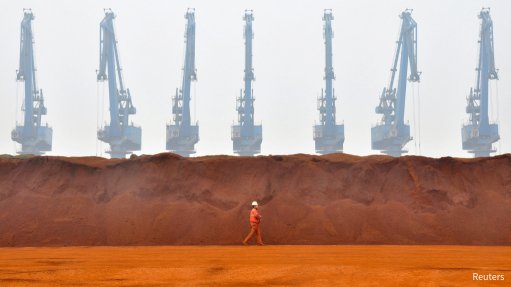Miner completes initial metallurgical tests
Canadian explorer West Mining Corporation announced in October that it had received final reports for initial metallurgical and mineralogical testwork completed on the Gold Mountain and Kena Gold Zones of its 100%-owned Kena Gold-Copper project, in south-eastern British Columbia.
The Kena Property hosts several large gold and copper zones. The Kena Gold and Gold Mountain Zones contain the recent gold resource estimate shells, hosting 2.77-million ounces of gold inferred about 560 000 oz of gold indicated at 0.25 g/t cutoff.
Testing company Bureau Veritas Minerals’ Metallurgical Division conducted a preliminary metallurgical testing programme on two composite drill core samples – Composite 1 from the Kena Gold Zone and Composite 2 from the Gold Mountain Zone.
The goal of this testwork is to evaluate the amenability of these samples to conventional mineral processing procedures.
Composite 1 and Composite 2 assayed 1.0g/million-tons gold and 0.906g/million tons gold, respectively, by averaging standard fire assay and metallic assay results.
QEMSCAN Bulk Mineral Analysis showed these the two test composites contained 3.7% to 4.1% sulphide minerals, mainly as pyrite. Silicates were the dominantly gangue minerals.
Gold deportment study by Trace Mineral Search showed that more than 99% of the gold in these two composites occurred as very fine-grained native gold and electrum. About 24% of the gold in Composite 1 were found in gold-tellurium bearing minerals. The average gold grain sizes of these two composite samples ranged from 1.6 μm to 2.3 μm.
Bond ball mill work index testing showed a BWi of 11 kWh/t for Composite 1 and 16 kWh/t for Composite 2 at a closing screen of 150 mesh, indicating that the mineralisation is moderate-hard to ball mill grinding.
Three process options including sulphide flotation, bottle roll cyanidation and gravity concentration were evaluated in this test program.
Sulphide flotation was able to recover up to 88.7% gold from Composite 1 and 90.5% gold from Composite 2 respectively, at 13.1% to 15.2% mass pulls.
Bottle roll cyanidation of ground whole-ore yielded encouraging gold recoveries of 80% to 85.5% from Composite 1, and 92.8% to 94% from Composite 2 by leaching at 40% solids for 72 hours using 1.0 g/ℓ sodium cyanide.
Results showed that in direct cyanidation, Composite 2 was not grind sensitive in the size range of 75 μm and 150 μm. In flotation tests, Composite 1 was not grind sensitive in the tested size range.
Gravity concentration alone was ineffective to recover gold from these samples. Single pass gravity concentration with cleaning yielded no more than 11.6% gold recoveries for both samples.
A combination of gravity preconcentration followed by cyanidation of gravity scalped tailing at 75 μm grind resulted in gold recoveries of 81.4% and 95.6% for Composite 1 and Composite 2 respectively.
A combination of gravity preconcentration at 75 μm followed by flotation of gravity tailings and then cyanidation of flotation concentrates yielded gold recoveries of 71.6% and 87.6% for Composite 1 and Composite 2 respectively.
This preliminary testing program showed that the two composite samples from the Kena Project are amenable to whole-ore cyanidation and sulphide flotation processes.
“This recent metallurgical testwork speaks volumes for the project and is a major step in our advancement of Kena as a whole. Combined with the earlier resource estimate, the nonrefractory nature of the mineralisation and the high gold recoveries are extremely positive parameters that allow the company to continue its successful path moving the project forward,” states of West Mining Corporation CEO Nicholas Houghton.
The initial phase of the 2022 diamond drilling programme on the Gold Mountain Zone, now completed, consisted of 2 400 m in nine diamond drill holes. Pending assay results will be released upon receipt.
Article Enquiry
Email Article
Save Article
Feedback
To advertise email advertising@creamermedia.co.za or click here
Press Office
Announcements
What's On
Subscribe to improve your user experience...
Option 1 (equivalent of R125 a month):
Receive a weekly copy of Creamer Media's Engineering News & Mining Weekly magazine
(print copy for those in South Africa and e-magazine for those outside of South Africa)
Receive daily email newsletters
Access to full search results
Access archive of magazine back copies
Access to Projects in Progress
Access to ONE Research Report of your choice in PDF format
Option 2 (equivalent of R375 a month):
All benefits from Option 1
PLUS
Access to Creamer Media's Research Channel Africa for ALL Research Reports, in PDF format, on various industrial and mining sectors
including Electricity; Water; Energy Transition; Hydrogen; Roads, Rail and Ports; Coal; Gold; Platinum; Battery Metals; etc.
Already a subscriber?
Forgotten your password?
Receive weekly copy of Creamer Media's Engineering News & Mining Weekly magazine (print copy for those in South Africa and e-magazine for those outside of South Africa)
➕
Recieve daily email newsletters
➕
Access to full search results
➕
Access archive of magazine back copies
➕
Access to Projects in Progress
➕
Access to ONE Research Report of your choice in PDF format
RESEARCH CHANNEL AFRICA
R4500 (equivalent of R375 a month)
SUBSCRIBEAll benefits from Option 1
➕
Access to Creamer Media's Research Channel Africa for ALL Research Reports on various industrial and mining sectors, in PDF format, including on:
Electricity
➕
Water
➕
Energy Transition
➕
Hydrogen
➕
Roads, Rail and Ports
➕
Coal
➕
Gold
➕
Platinum
➕
Battery Metals
➕
etc.
Receive all benefits from Option 1 or Option 2 delivered to numerous people at your company
➕
Multiple User names and Passwords for simultaneous log-ins
➕
Intranet integration access to all in your organisation


















